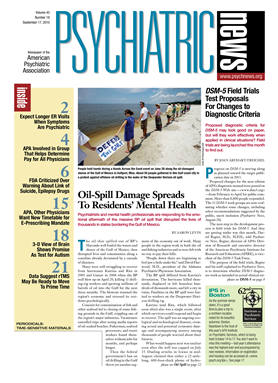Although self-help organizations have had a mixed record in terms of their outcomes for psychiatric patients, new research indicates that a particular model produces improved recovery compared with the clinical approaches used by community mental health agencies.
Self-help agencies (SHAs) in the form of patient-run mental health service organizations can produce better recovery outcomes for people with serious mental illness when paired with community mental health centers (CMHCs), than CMHCs can achieve on their own, according to a study in the September Psychiatric Services.
Nonprofit self-help agencies, which may be government-funded or independently operated, generally function as drop-in case-management programs that provide people with assistance in their job searches and skills training and with their housing searches, as well as providing crisis-intervention services and education programs. Some also function as patient-advocacy programs.
The study assigned weighted samples of 505 new patients seeking CMHC services to either regular CMHC services or to combined SHA-CMHC services at five proximally located programs.
The patients who received combined services showed greater improvements in “personal empowerment,” self-efficacy, and independent social integration, according to the study. Additionally, feelings of hopelessness and the symptoms of their illnesses dissipated more quickly and to a greater extent in the combined approach than among patients using only CMHC-provided care.
The findings are significant, said Steven Segal, Ph.D., M.S.W., the study's lead author, because many clinicians remain skeptical of the utility of self-help programs in improving patient outcomes, even as a growing number of local governments seek to pair them with CMHCs.
“Getting people involved in decisions about their own care helps them improve their lives overall,” Segal said in an interview with Psychiatric News.
The findings should help put to rest some skepticism about how well “bottom-up” SHAs—those organized and directed by their patient-clients—can function alongside more established CMHCs and contribute to their members' clinical outcomes, he said.
Sanjay Gupta, M.D., immediate past president of the American Academy of Clinical Psychiatrists, told Psychiatric News that many of his patients have benefited from participation in self-help programs combined with clinical treatment.
“When patients have a say in what they want to do ... then their motivation to participate in something they design is much greater,” Gupta said.
In addition, such findings could help eliminate some of the stigma directed at people with mental illness, even from some clinicians, in terms of patients' ability to contribute to their own care and recovery.
“The tendency is to assume that if you're mentally ill then you're stupid or not responsible,” Segal stated. But these findings illustrate that unless they are in the midst of an acute exacerbation of their illness, most people with mental illness are quite responsible about their care.
Gupta agreed that patients with less severe mental illness should have a greater role in designing their self-help programs, but with clinicians providing “guard rails” to prevent the inclusion of unhelpful features.
The findings give a more positive view of self-help programs than did some earlier research, including a 2007 study led by E. Sally Rogers, Sc.D., director of research for the Center for Psychiatric Rehabilitation at Boston University, which was funded by the Substance Abuse and Mental Health Services Administration. That study, published in the November 6, 2007, Journal of Rehabilitation Research and Development, examined a variety of SHAs and found that the benefits of self-help programs were “significant but small in magnitude.” However, Segal noted that the study by Rogers was limited by its inclusion of self-help entities organized in very different ways, which may have diluted the benefits of the few patient-driven programs included in the study.
Segal emphasized that the particular organizational approach used by specific SHAs is critical to their effectiveness for people with mental illness. The most effective versions of these organizations, he said, are those organized from the “bottom up,” which allowed their patient-members to vote on all of their key functions, including hiring and firing of their personnel. Such programs may not appear to run as smoothly as those led by mental health professionals; however, the patient-directed programs appear to produce better results.
“What can look chaotic can be effective,” Segal emphasized.
Segal, who has studied such patient-directed organizations for many years, said that the bottom-up approach is more difficult to initially launch and maintain. However, its improved efficacy likely stems from its ability to give a sense of control to patients, which can encourage them to view their own illness as manageable as long as they stick with recommended treatment, despite occasional clinical setbacks.
“Most importantly, these [SHA patients] were socially involved and integrated, which was associated with reductions in symptomatology and hopelessness, and that's really something,” he said.
Gupta said patient-designed programs can allow their unique perspective to inform efforts aimed at helping develop healthy lifestyles. For instance, dietary plans that patients cannot financially afford to follow can be replaced—through patient leadership—with compromise approaches that are beneficial and affordable.
“If [patients] design the program then they see it from their perspective, which neither you nor I have,” he said.
